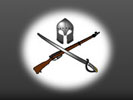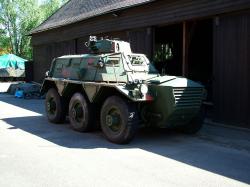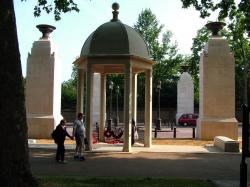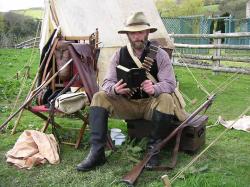Translate this Page
Camperdown.
Battle Name : Camperdown.
Date(s) : 11 October 1797
Part of : The French Revolutionary and Napoleonic Wars , French War of the First Coalition ,
Outcome : A victory for British Fleet over Dutch Fleet
Type of battle : Sea
Summary
The British and the Dutch had equal numbers of line-of-battle ships [16]. Vice-Admiral de Winter tried to manoeuvre the British over the shallows but Admiral Duncan abandoned attempts to form a line of battle and attacked precipitately. The result was the British formed a two division attack similar to that used by Nelson at Trafalgar and gained a similar decisive outcome.
Location
Southern North Sea off the Dutch town of Kamperduin.
More details
The French strategic plan to unite the Spanish, Dutch and their own fleets and thereby dominate the Channel had in part been foiled at the Battle of Cape St. Vincent. However the Dutch fleet was still intact and remained a menace to the important British trade routes to and from the Baltic. Admiral Duncan was appointed to command the North Sea fleet in February 1794, the fleet was ill equiped and in 1797 suffered the muntiny at the Nore. For a two month period the blockade of the Dutch fleet in the Texel was maintained by just two line-of-battle ships maintaining a bluff by frequently signalling to a fleet standing out of sight of land. By the end of June the North Sea fleet was again up its full fighting efficiency.
The French and Dutch got word of the mutinies and prepared plans to put Dutch troops on board ships and go through with the invasion of Ireland. By the time they had acted upon their plans it was too late as the British were back up to strength. The waiting game continued.
In October the Revolutionary Committee ordered de Winter to take the Dutch fleet to sea and seek a battle with the British. No further military objective was set. De Winter had no choice but to carry out the order, which he did to the best of his ability, although his fleet had not been to sea for two years and their sailing and gun drills were only harbour practiced. On the 7th October the Dutch left the Texel and proceded slowly south west. The watching British in-shore squadron was under the command of Captain Trollope who sent a ship to warn Duncan, left another on station to direct the fleet when it arrived, and with his remaining ships he shadowed the Dutch fleet. When Duncan's fleet arrive off the Texel he was informed by Active that the Dutch had sailed south west. Duncan headed southwest and at 0900 hrs on the 11th October he made contact with Captain Trollope who was watching the Dutch.
The weather was clear, sea conditions good with a steady north westerly blowing.
The Dutch fleet was in a single line of battle heading north-east back towards the Texel. De Winter did not want to avoid an engagement but he did want to fight it on the most advantageous terms. His tactics were to lure the British ships over the shoal waters nearer the shore. Here the Dutch ships with their shallower draught would be at a distinct advantage. He ordered his ships to 'haul their wind' which left them drifing, still in formation, in towards the shallows.
The British had become separated into two groups. The leeward, more southerly group, of nine ships was under the command of Vice-Admiral Onslow was closer to the Dutch than the other group. Duncan had seven ships with him in the windward, more northerly group. He gave the order to 'form a line of bearing' which would mean his ships attacked in line abreast [As Howe intended on the Glorious First of June]. As the first moves were made to execute the order it became obvious to Duncan that the Dutch would be over the shallows before his ships could engage. Duncan changed his order to each ship pick its own opponent, attack at once and manoeuvre between the Dutch and the shallows. This order was promptly obeyed.
First into action were Onslow's nine ships which closed rapidly on the five ships at the rear of the Dutch line and engaged them almost two to one. As this was happening Duncan's group of seven got in among the leading eleven Dutch. For a while things were touch and go with Duncan's squadron particularly his flagship which was under attack by three Dutch ships at the same time. Captain Bligh [of the Bounty] commanding Director, 64, who was in Onslow's group realised that the Dutch rear was overwhelmed and that Duncan's group was in some difficulty. He broke away from Onslow's group and went to support Duncan's group. He was followed by Powerful, 74, and Montague, 74. The balance changed to ten British to eleven Dutch.
In all the hard fought action lasted two and a half hours. The general drift of the ships was east of north-east taking them towards the Texel and more significantly towards the shallows.
Duncan broke off the engagement and nine of the Dutch line-of-battle ships escaped. The British took seven line-of-battle ships, two fourth rates and two frigates [the frigates had had the audacity/bravery to fire on line-of-battle ships]. One Dutch flag officer, Rear-Admiral Reyntjes, was killed and three others, including de Winter, were captured.
This battle effectively took the Dutch fleet out of the French Revolutionary Committee's side of the equation, it did not put to sea again. The British trade with the Baltic was secure from naval attack, the second third of the French strategic plan had be thwarted.
The evolving British naval tactics in which Admirals gave more responsibility to their Captains was again tried, tested and found effective. Bligh's move from Onslow's group was similar in principle to Nelson's move at Cape St. Vincent.
Casualty figures
Dutch Fleet
- Number engaged :
- 10,600
- Casualties :
- 1,100 (10.38%)
British Fleet
- Number engaged :
- 9,400
- Casualties :
- 1,000 (10.64%)






